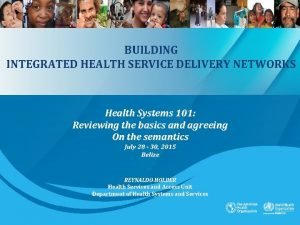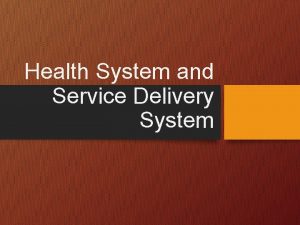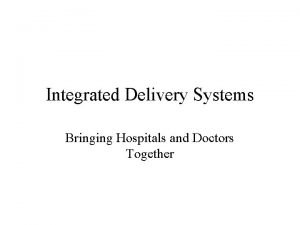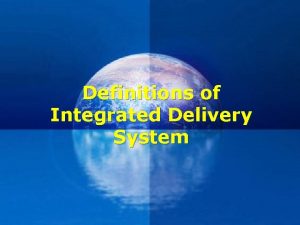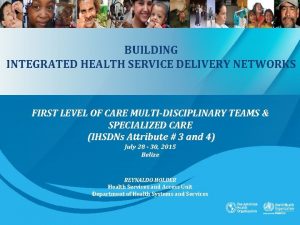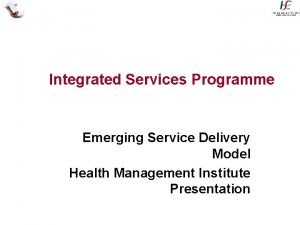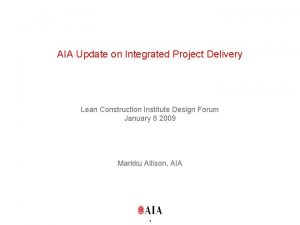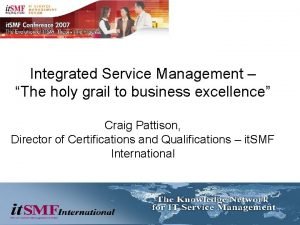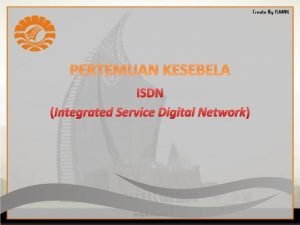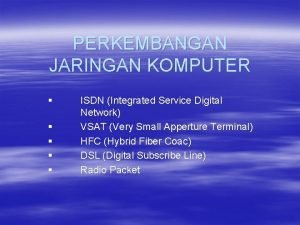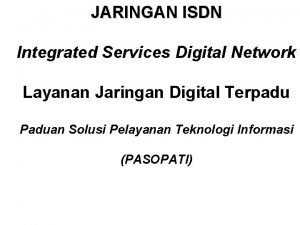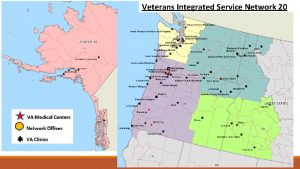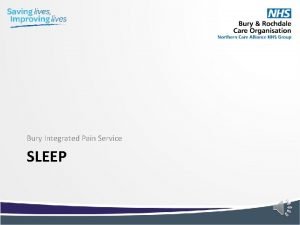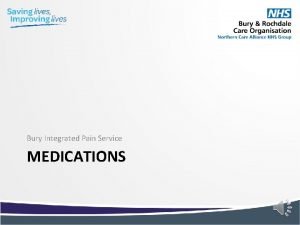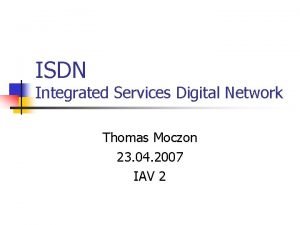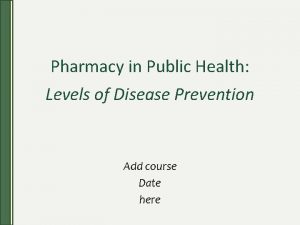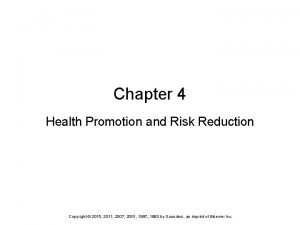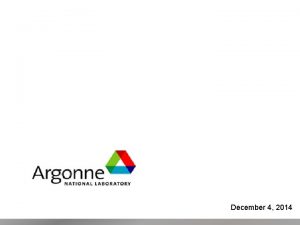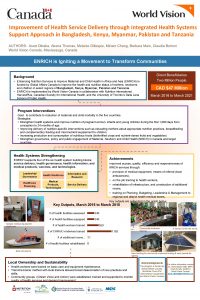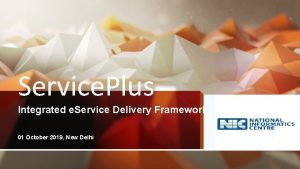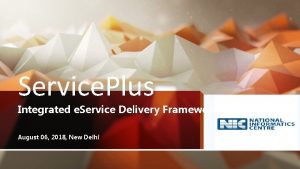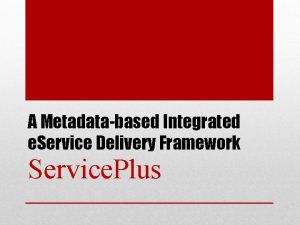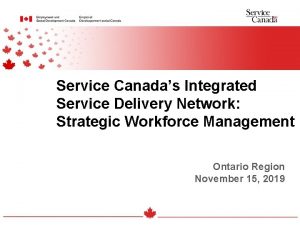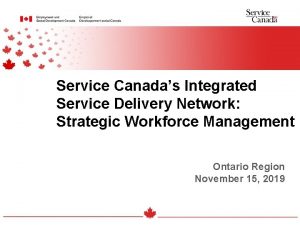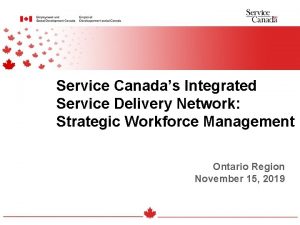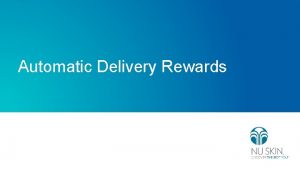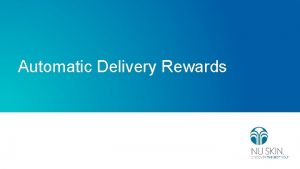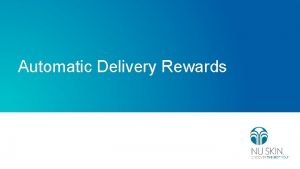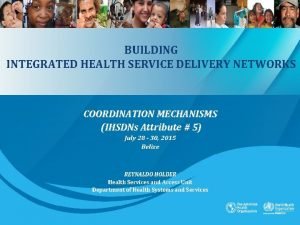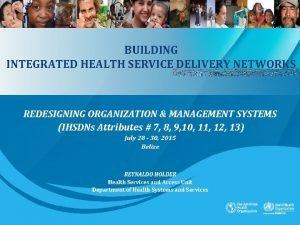Integrated service delivery to transform health The Disease





















- Slides: 21

Integrated service delivery to transform health

The Disease Burden South Africa is in the grips of a disease cocktail that leads to high rates of illness and unnecessary death at all the critical points in the human life-cycle. In its enormity and combination, the disease burden in South Africa is harmful to the health and wealth of everyone, individually and collectively as a country as a whole. 2020 -10 -25 Tessa Marcus Jannie Hugo Department Of Family Medicine UP

AN OVERBURDENED HEALTH CARE SYSTEM DESIGNED TO EXCLUDE AND TO FAIL 2020 -10 -25 Tessa Marcus Jannie Hugo Department Of Family Medicine UP

The Challenge – To Change the Game 80% of health happens in the community 2020 -10 -25 Tessa Marcus Jannie Hugo Department Of Family Medicine UP

Our Approach: Community Oriented Primary Care Creates a primary care service-learning-research platform that 1. is geographically bounded (wards and suburbs) 2. extends from home to and from health facilities and across sectors in defined places( homes, education, work, recreation). 3. is organizationally situated in a complex, layered and multi-partner service delivery system mobilizes skills and expertise across all sectors 4. around a common vision of doing primary health 5. using the best available knowledge and practice. 2020 -10 -25 Tessa Marcus Jannie Hugo Department Of Family Medicine UP

All Practice Guided by 5 COPC Principles 2020 -10 -25 Tessa Marcus Jannie Hugo Department Of Family Medicine UP

Our Paradigm = Health as a Complex Adaptive System • These are made up of • Connections, interactions many parts or elements. and relationships are particularly important • The parts or elements are all important • They produce emergent behaviors • But breaking down each does not help you • These are different from understand the system. or greater than the possible behaviors of • What matters is how each part. elements connect and interact with one another. 2020 -10 -25 Tessa Marcus Jannie Hugo Department Of Family Medicine UP

THE PROBLEM – OUR APPROACH TO MANAGING COMPLEXITY 2020 -10 -25 Tessa Marcus Jannie Hugo Department Of Family Medicine UP

The Management Challenge- To Improve Health by Managing Services for Complexity Mobilise • people’s skills and intelligence to address fluid and contradictory requirements • without creating complicatedness • without imposing processes and formal guidelines on frontline employees By creating an environment where • people work with one another • to find creative solutions to complex challenges 2020 -10 -25 Tessa Marcus Jannie Hugo Department Of Family Medicine UP

Morieux’s “Six Smart Rules” Harvard Business Review September 2011 Enabling Rules to help people make better choices Impelling Rules to Support Cooperation 1 4 Increase the need for reciprocity Improve understanding of what coworkers do – – People have to understand each others work by observing and interacting 2 Reinforce the integrators – Integrators are people who interact with multiple stakeholders 3 Expand the amount of power available – 2020 -10 -25 give people responsibility for the issues that matter to them/ their organisation or team and others When people’s actions depend on give and take they see the value of helping each other 5 Make people feel the shadow of the future – Hold people accountable for the consequences of their decisions Put the blame on the uncooperative – – People should not be punished for mistakes or failing – they should be punished for not asking for help or for not helping. Tessa Marcus Jannie Hugo Department Of Family Medicine UP

THE PROBLEM – POOR HEALTH KNOWLEDGE SKILLS LITERACY 2020 -10 -25 Tessa Marcus Jannie Hugo Department Of Family Medicine UP

THE CHALLENGE – TO CREATE CAPABILITY HEALTH CARE PROVIDERS ARE PRESENT (INVESTED) USE THE BEST AVAILABLE KNOWLEDGE TO DELIVER MEANINGFUL QUALITY SERVICES 2020 -10 -25 Tessa Marcus Jannie Hugo Department Of Family Medicine UP

OUR APPROACH TO CREATING CAPABILITY: CONTINUOUS FACILITATED PEER LEARNING 2020 -10 -25 Tessa Marcus Jannie Hugo Department Of Family Medicine UP

Our Practice…geographically defined coordinated & integrated service for health 2020 -10 -25 Tessa Marcus Jannie Hugo Department Of Family Medicine UP

Using ICT enabled micro-macro information flows to support Service 2020 -10 -25 Learning Research Tessa Marcus Jannie Hugo Department Of Family Medicine UP Communication

Through Adaptive Action Planning that shows macro and meso patterns AND enables micro level practice http: //hikm. ihe. nl/floodsite/data/T ask 25 S/04_Evacuation. Models. htm 2020 -10 -25 Tessa Marcus Jannie Hugo Department Of Family Medicine UP

Example: Pregnant Women in WBOT Registered Households-City of Tshwane 22 September 2014 - May 6 2015 Percent per female age group Total Pregnant 701/ 21, 968 (3, 19% of reference population) Percent Pregnant 7 6 5 4 3 2 1 0 10 11 12 13 14 15 16 17 18 19 20 21 22 23 24 25 26 27 28 29 30 31 32 33 34 35 36 37 38 39 40 41 42 43 44 45 46 47 48 49 Dr Hans-Friedemann (Fritz) Kinkel 2015 2020 -10 -25 Age group (year) Tessa Marcus Jannie Hugo Department Of Family Medicine UP

Example: Post-Natal Women in WBOT Registered Households-City of Tshwane Percent per female age group 22 September 2014 - May 6 2015 4. 5 4 3. 5 3 2. 5 2 1. 5 1 0. 5 0 Total Postnatal 284/ 22, 023 (1. 29% of reference population) Teenagers = 11% of women in postnatal period) 10 11 12 13 14 15 16 17 18 19 20 21 22 23 24 25 26 27 28 29 30 31 32 33 34 35 36 37 38 39 40 41 42 43 44 45 46 47 48 49 Dr Hans-Friedemann (Fritz) Kinkel 2015 2020 -10 -25 Age group (year) Tessa Marcus Jannie Hugo Department Of Family Medicine UP

Example: ANC and PNC Adaptive Action Planning In COPC DISTRICT MANAGEMENT • Overview of Learning, Service Research – • Mobilising Resources for 156 wards, 7 District Health Regions, 680, 000 households • N x 3, 19% • N x xx% pregnant women not in ANC • +70% of female population in need of family planning, HTC, STI preventin IPWESST • Integration, Coordination, Cooperation, Clinical Oversight, • Support N x WBOT Team Leaders by developing • Learning action plans. Service support plans • Research support plans • Communication support plans WBOT Team Leader • Facilitating Learning action plan for 10 -20 CHWs • (ANC, Family Planning, HCT, Post Natal. Ccare and infant feeding, ECD, Infection control, Emergency Care) • Service planning a 10 -20 CHWS • (ANC, Family Planning, HCT, Post Natal care and infant feeding, ECD, Infection control, Emergency Care, ) CHW • Plan services to pregnant woman and households with pregnant women (? 2 of 200 households) • Plan services to postnatal mothers and neonates and infants (? 5 of 200 households) • Plan services to households with girls and women at risk of pregnancy (? 10 of 200 households) • Learn/update essentials of ANC, HCT, post-natal care and infant feeding, ECD • Plan health promotion ad prevention on family planning and HCT and STI for all households demographically at risk. (prioritise by household composition and risk, other conditions). 2020 -10 -25 Tessa Marcus Jannie Hugo Department Of Family Medicine UP

WHERE DO YOU FIT IN? 2020 -10 -25 Tessa Marcus Jannie Hugo Department Of Family Medicine UP

A Presentation by Tessa Marcus Department of Family Medicine University of Pretoria THE UP COPC LIVING LAB Jannie Hugo Tessa Marcus Hans Fritz Kinkel Nomonde Bam Philemon Mahume Jacques de Vos Japie de Jongh Kate van den Bergh 2020 -10 -25 Nina Honibal
 Integrated delivery network definition
Integrated delivery network definition Service delivery objectives
Service delivery objectives Communicable disease and non communicable disease
Communicable disease and non communicable disease What are the advantages of an integrated delivery network?
What are the advantages of an integrated delivery network? Integrated delivery
Integrated delivery Bim introduction ppt
Bim introduction ppt First level service
First level service Integrated services delivery
Integrated services delivery Aia integrated project delivery
Aia integrated project delivery Task 1833 in adm
Task 1833 in adm Ism integrated service management
Ism integrated service management Arsitektur isdn
Arsitektur isdn Isdn komputer adalah
Isdn komputer adalah Isdn adalah jaringan
Isdn adalah jaringan Visn 20
Visn 20 Bury integrated pain service
Bury integrated pain service Bury integrated pain service
Bury integrated pain service Integrated service digital network
Integrated service digital network Integrated service management
Integrated service management Classicism is health romanticism is disease
Classicism is health romanticism is disease Health promotion and levels of disease prevention
Health promotion and levels of disease prevention Health promotion and levels of disease prevention
Health promotion and levels of disease prevention
